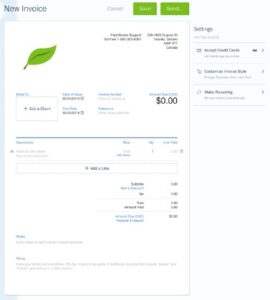
Before you even send out an invoice, it’s crucial to assess the creditworthiness of your customers. This is especially important if transactions involve significant sums and extended payment terms. For comparison, in the fourth quarter of 2021 Apple Inc. had a turnover ratio of 13.2. Accounts receivable are an important aspect of a business’s fundamental analysis. Accounts receivable is a current asset, so it measures a company’s liquidity or ability to cover short-term obligations without additional cash flows.
What if they don’t pay?
Adhering to federal, state, and industry-specific requirements minimizes the risk of fines, penalties, and legal issues. Non-compliance can result in reputational damage, financial simple invoices in 9 steps losses, and legal liabilities on the other hand. Here is a survey that analyses Q DSO, DPO, and DIO performance of 1,000 of the largest public companies in the United States.

Requirements and skills
A typical AR report shows how much revenue has been generated by invoicing clients for products or services. Accounts receivable are considered assets because they represent money owed to your business. There are few things more frustrating than struggling to give someone money. On paper, this should be a relatively easy https://www.kelleysbookkeeping.com/the-ecommerce-guide-to-bookkeeping/ task, but overly complicated or error-prone A/R processes can drag out the entire timeline. Conversely, an efficient, honest, and reliable payment process can improve customer satisfaction and even higher sales. In other words, when you buy on credit, it affects your A/P, and when you sell on credit, it affects your A/R.
The accounts receivable process

However, this process requires clear policies and regulations and a well-controlled system. Your company can use accounts receivable as collateral for loan applications and to fulfill short-term money obligations. You can receive customer payments through different channels, including wire transfers, virtual credit cards, ACH payments, or paper checks. Electronic invoices may include different formats like emailed bills or using invoices generated and sent through invoice accounts receivable software. To calculate the Best Possible DSO, divide the current accounts receivable by the total credit sales, then multiply by 365. The Best Possible DSO shows the average days your customers take to pay you, assuming they always pay on time.
What is the primary goal of accounts receivable management?
Frequently reviewing and analyzing financial data is also important for re-assessing any strategies that need to be improved. It’s a good practice to initiate dispute resolution promptly if any issues arise. This helps maintain positive customer relationships and increases the chances of invoice payment.
- Intuit Inc. does not have any responsibility for updating or revising any information presented herein.
- Here is a survey that analyses Q DSO, DPO, and DIO performance of 1,000 of the largest public companies in the United States.
- Here are the most popular options—including one you should definitely avoid.
When it comes to facilitating payments, providing multiple options is paramount. This approach ensures that customers can make payments even when their authorized personnel are unavailable due to travel or other commitments. Establishing a consistent invoice delivery schedule prompts customers to anticipate and prepare for on-time payments. When recording accounts receivable, you want to post the revenue in the month you earn it. This will keep your accounting records accurate and consistent with accrual accounting. A typical aging schedule groups invoices by their number of days outstanding, such as 0-30 days, days, days, and over 90 days.
Furthermore, accounts receivable are current assets, meaning that the account balance is due from the debtor in one year or less. If a company has receivables, this means that it has made a sale on credit but has yet to collect https://www.online-accounting.net/ the money from the purchaser. At HighRadius, our team of fintech experts collaborates with companies to comprehend their unique requirements and provide tailored solutions to simplify accounts receivable management.
You can do this manually by preparing and sending a paper bill through the mail or electronically. Company A promptly brings in a mediator, who reminds Company B that the delivery charge was outlined on the sales order. Now that you know what a successful Accounts Receivable process is and why it’s valuable, you might be wondering how to get started. The 8 steps outlined below provide a foundation for creating a simple and effective Accounts Receivable process. Here are the most popular options—including one you should definitely avoid.

Accounts Receivable is the amount a business holds in ongoing customer debts. An efficient Accounts Receivable process is key to ensuring good cash flow, maintaining positive customer relations, and collecting payments. A low DSO means that customers are paying promptly after receiving their invoices and that your team is quickly processing the payments. This correlates to good cash flow and lower amounts of bad debt write-offs.
If you find that customers are regularly late with their payments, you may choose to extend the length of time before you write off unpaid invoices as bad debt. In cases where all attempts at collection management fail, a business may have no choice but to write off the bad debt. It’s helpful to have an established timeline for when your company considers unpaid invoices to become bad debt. This process is also valuable because it encourages businesses to assess potential customers and build a credible customer base. Although businesses have the option to write off uncollectible debt, it’s still better to select customers with a proven track record of positive debt repayment.
For example, you can automate the invoicing using automated templates like free invoice builders and setting recurring invoices for installments or subscriptions. With good software, you can also automate payment reminders for your customers. Giving customers various payment alternatives may reduce the need to collect receivables later. In addition to cash in person and EFTs, you can utilize dedicated financial services for international payments. To calculate your AR turnover ratio, divide your net credit sales by the average accounts receivable. You can effectively manage increased orders and payment processing through online tools, while self-serve options can reduce the need for additional customer support members.

